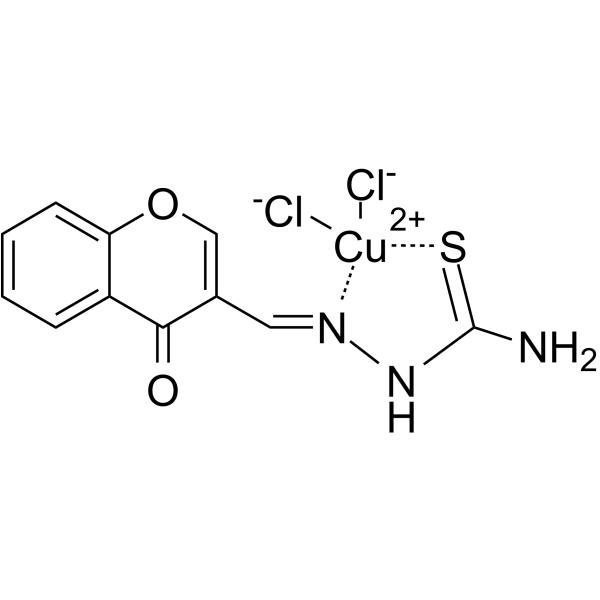Physicochemical Properties
| Molecular Formula | C11H9CL2CUN3O2S |
| Molecular Weight | 381.73 |
| Exact Mass | 379.909 |
| CAS # | 902779-59-3 |
| PubChem CID | 56972210 |
| Appearance | Light green to green solid powder |
| LogP | 3.427 |
| Hydrogen Bond Donor Count | 2 |
| Hydrogen Bond Acceptor Count | 4 |
| Rotatable Bond Count | 2 |
| Heavy Atom Count | 20 |
| Complexity | 395 |
| Defined Atom Stereocenter Count | 0 |
| SMILES | C1=CC=C2C(=C1)C(=O)C(=CO2)/C=N\NC(=S)N.Cl[Cu]Cl |
| InChi Key | HZRXQEVFXXQYFS-KHDHKOIVSA-L |
| InChi Code | InChI=1S/C11H9N3O2S.2ClH.Cu/c12-11(17)14-13-5-7-6-16-9-4-2-1-3-8(9)10(7)15;;;/h1-6H,(H3,12,14,17);2*1H;/q;;;+2/p-2/b13-5-;;; |
| Chemical Name | dichlorocopper;[(Z)-(4-oxochromen-3-yl)methylideneamino]thiourea |
| HS Tariff Code | 2934.99.9001 |
| Storage |
Powder-20°C 3 years 4°C 2 years In solvent -80°C 6 months -20°C 1 month |
| Shipping Condition | Room temperature (This product is stable at ambient temperature for a few days during ordinary shipping and time spent in Customs) |
Biological Activity
| ln Vitro | In BT20, PC-3, COLO 357, and BxPC-3 cancer cell lines, FPA-124 demonstrates dose-dependent growth inhibitory effects with IC50s of 7, 10, 34, and 55 μM, respectively[1]. |
| ln Vivo | In a well-established orthotopic pancreatic tumor model employing COLO 357 cells, FPA-124 promotes NF-κB inactivation and demonstrates PKB (Akt protein) inhibitory activities[1]. |
| References |
[1]. Synthesis, molecular characterization, and biological activity of novel synthetic derivatives of chromen-4-one in human cancer cells. J Med Chem. 2006 Jun 29;49(13):3800-8. [2]. Pioglitazone enhances collateral blood flow in ischemic hindlimb of diabetic mice through an Akt-dependent VEGF-mediated mechanism, regardless of PPARgamma stimulation. Cardiovasc Diabetol. 2009 Sep 8;8:49. |
Solubility Data
| Solubility (In Vitro) |
DMSO : 5 mg/mL (13.10 mM) H2O : < 0.1 mg/mL |
| Solubility (In Vivo) |
Solubility in Formulation 1: ≥ 0.67 mg/mL (1.76 mM) (saturation unknown) in 10% DMSO + 40% PEG300 + 5% Tween80 + 45% Saline (add these co-solvents sequentially from left to right, and one by one), clear solution. For example, if 1 mL of working solution is to be prepared, you can add 100 μL of 6.7 mg/mL clear DMSO stock solution to 400 μL PEG300 and mix evenly; then add 50 μL Tween-80 to the above solution and mix evenly; then add 450 μL normal saline to adjust the volume to 1 mL. Preparation of saline: Dissolve 0.9 g of sodium chloride in 100 mL ddH₂ O to obtain a clear solution. Solubility in Formulation 2: 0.67 mg/mL (1.76 mM) in 10% DMSO + 90% (20% SBE-β-CD in Saline) (add these co-solvents sequentially from left to right, and one by one), suspension solution; with ultrasonication. For example, if 1 mL of working solution is to be prepared, you can add 100 μL of 6.7 mg/mL clear DMSO stock solution to 900 μL of 20% SBE-β-CD physiological saline solution and mix evenly. Preparation of 20% SBE-β-CD in Saline (4°C,1 week): Dissolve 2 g SBE-β-CD in 10 mL saline to obtain a clear solution. (Please use freshly prepared in vivo formulations for optimal results.) |
| Preparing Stock Solutions | 1 mg | 5 mg | 10 mg | |
| 1 mM | 2.6197 mL | 13.0983 mL | 26.1965 mL | |
| 5 mM | 0.5239 mL | 2.6197 mL | 5.2393 mL | |
| 10 mM | 0.2620 mL | 1.3098 mL | 2.6197 mL |
